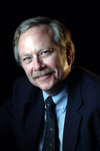Colloquia & Guest Speakers
Application Efficacy: A simple method for minimizing wasted lighting energy
Mark Rea, Lighting Research Center and Rensselaer Polytechnic Institute
Monday, November 3, 2014
3 p.m.–4 p.m.
Goergen 101, Sloan Auditorium
Abstract:
Lamp or luminaire efficacy is defined in terms of luminous efficacy, lumens per watt. The common belief, indeed the basis for energy regulation, is that luminous efficacy equates to lower power demand from a lighting system. This is incorrect because luminous efficacy is not defined in terms of “useful” lumens per watt. Light that is directed to locations outside the desired area for illumination is wasted and can cause negative effects such as light discomfort glare and light pollution. The concept of application efficacy was developed to minimize wasted lighting energy and the collateral negative effects associated with poor optics. Since its original development, the concept of application efficacy has been further developed to consider spectral and temporal factors as well.
Bio:
 Dr. Rea is the director of Rensselaer Polytechnic Institute's Lighting Research Center and an expert in human vision, lighting engineering, human factors, photobiology, psychology, light and health, nighttime vision, and visual performance. He is the author of more than 100 scientific and technical articles related to vision, lighting engineering, and human factors and was the editor-in-chief of the 8th and 9th editions of the Illuminating Engineering Society of North America Lighting Handbook. His current research projects include the study of the effects of light and circadian disruption on breast cancer, research on the effects of daylight on worker productivity in commercial offices, the development of new metrics to improve the acceptance of energy-efficient lighting technologies, and research on reducing the market barriers to widespread use of energy-efficient lighting controls.
Dr. Rea is the director of Rensselaer Polytechnic Institute's Lighting Research Center and an expert in human vision, lighting engineering, human factors, photobiology, psychology, light and health, nighttime vision, and visual performance. He is the author of more than 100 scientific and technical articles related to vision, lighting engineering, and human factors and was the editor-in-chief of the 8th and 9th editions of the Illuminating Engineering Society of North America Lighting Handbook. His current research projects include the study of the effects of light and circadian disruption on breast cancer, research on the effects of daylight on worker productivity in commercial offices, the development of new metrics to improve the acceptance of energy-efficient lighting technologies, and research on reducing the market barriers to widespread use of energy-efficient lighting controls.
